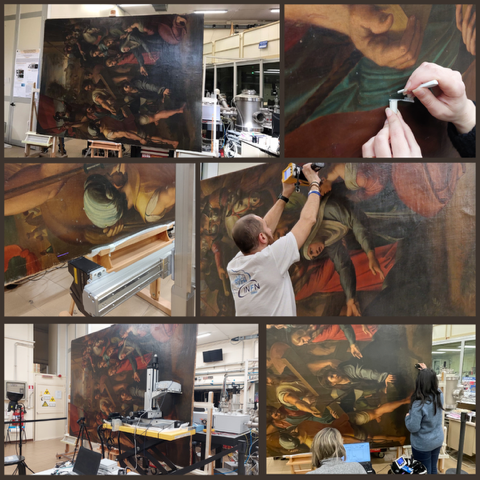 An unknown version of the painting “Lo Spasimo di Palermo” by Raffaello Sanzio was hosted at the DAΦNE-Light laboratory of the National Laboratories of Frascati of INFN to carry out a diagnostic campaign aimed to reveal the mysteries held by the artwork.
An unknown version of the painting “Lo Spasimo di Palermo” by Raffaello Sanzio was hosted at the DAΦNE-Light laboratory of the National Laboratories of Frascati of INFN to carry out a diagnostic campaign aimed to reveal the mysteries held by the artwork.
The painting, as the original one, which is now conserved at the Prado Museum of Madrid, has undergone a troubled history, through wars and numerous journeys, hiding many questions behind its creation and commissioning.
A group of researchers of the INFN-Cultural Heritage Network (CHNet) coming from LNF and the University of Roma Tre, and art historians of the Academy of Fine Arts in Rome worked together to study the painting.
To give answers to the diagnostic issues posed by art historians, some of the most innovative technologies have been used: the new multi-technique scanner, developed at the National Laboratories of Frascati, in the field of ARTEMISIA project (ARTificial intelligence Extended-Multispectral Imaging Scanner for In-situ Artwork analysis) and the profilometer scanner developed at Universtiy of Roma Tre in the field of PERSEPOLY project (Protecting hEritage by x-Ray SpEctroscopy and PrOfiLometrY). Furthermore, some micro-samples will be analyzed at the DAΦNE-LIGHT synchrotron radiation laboratory (National Laboratories of Frascati) to identify the stratigraphy of the paint layers. Thanks to scientific investigations it was possible to recover the inscription showing the year of the painting’s realization; this information, together with other data, could bring to the definitive confirmation of the royal commission. The obtained results will allow the reconstruction of the artist’s pictorial technique, the identification of the pictorial materials and the presence of restoration treatments. All this information will be essential for art historians to reconstruct the history of this painting.
This work is the result of a synergical collaboration between different professionals such as researchers, art historians and restorers; the results will be presented in a dedicated workshop in the autumn 2024.
 INFN-LNF Laboratori Nazionali di Frascati
INFN-LNF Laboratori Nazionali di Frascati